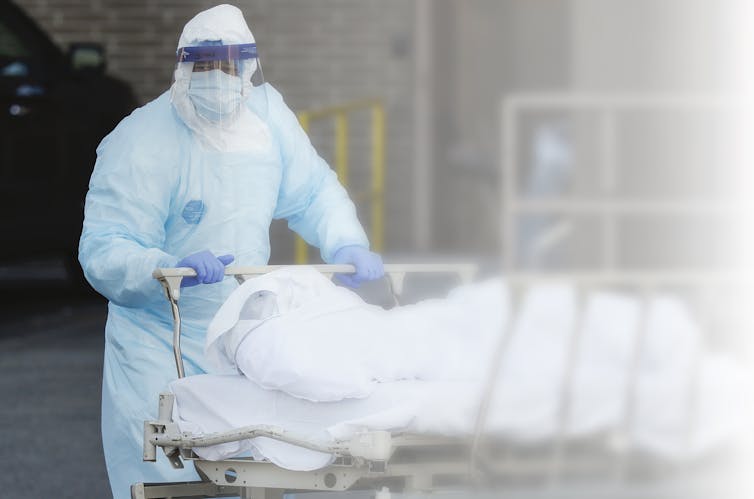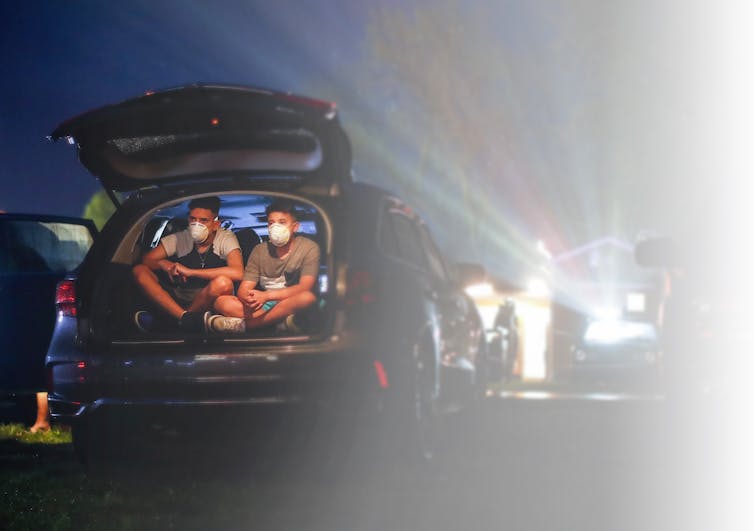As collective memory fades, so will our ability to prepare for the next pandemic
A global pandemic might be at the forefront of everyone's minds. But we can't assume that future threats will get the attention they deserve from people living in an information-saturated world.

Just below the Japanese village of Aneyoshi, there’s a stone carved with a warning: “Remember the calamity of the great tsunamis. Do not build any homes below this point.”
Placed there after a tsunami devastated the area in 1933, it helped those who listened to it remain safe from a similar disaster in 2011, almost 80 years later.
When the last wave of the coronavirus recedes, what kind of guide stone will exist for future generations?
This question is not just about recording history for history’s sake. As a political philosopher, I see it addressing an ancient problem of my field: how to ensure societies remain stable over time. Tangible reminders – anything from stone tablets to digital artifacts storing information about an event – help sustain collective memory of risk.
However, the global scope and relative infrequency of pandemics like the coronavirus make them especially challenging to collectively remember.
Burdens of bias
An unprecedented effort is underway to fill vast digital archives with information related to the pandemic. Researchers at the University of Arizona, for example, have started a project called A Journal of the Plague Year: An Archive of Covid-19 that invites the public to contribute everything from personal videos to Instagram posts and internet memes about life during the coronavirus.
But simply storing information in a repository isn’t enough; people will neither be able to access nor interpret it without the proper social and technological infrastructure.
For a reminder to be truly effective, huge swaths of the population must recognize the risk and be able to adequately prepare.
Motivating people to achieve this latter aim is the biggest challenge. We are biased in many ways toward our personal experience, and we tend to underestimate or dismiss risks unless we encounter them firsthand.
Take the town of Eilenburg, Germany, which sits along the Mulde River. Residents had lived through many small floods, so they knew that water posed a hazard. They were nonetheless unprepared when, in 2002, a flood event of a kind that hits Europe about once every 100 years inundated the town. Because the smaller floods hadn’t been a big deal, they had a warped understanding of the true risk of a major flood. Many consequently doubted official warnings that the river was about to rise as high as it did. The same pattern of bias has been observed in other disasters, such as earthquakes and volcanic eruptions.

Challenges from this bias grow over time. All events eventually disappear from living memory – a process that takes about 90 years. Once this happens, later generations have fewer opportunities to have compelling conversations with eyewitnesses. These interactions are important motivators for taking the threat of recurrence seriously. The disappearance of vivid personal memories of polio, whooping cough and measles has plausibly contributed to the rise of anti-vaccination sentiment, in spite of the well-documented danger of these diseases.
Challenges from technology
Perhaps bias can be overcome to some extent through technology. Watching videos of life in quarantine or interviews of those impacted by the coronavirus is the closest that future generations can get to experiencing the pandemic firsthand or having conversations with those who did.
But video and other media ultimately don’t provide conversation – only monologue. There were videos of eyewitness testimony and prudent accounts from historians about the last comparable global pandemic, the 1918 Spanish Flu. And yet tangible reminders like these do not seem to have caused the public to form an accurate perception of risk.
Counterintuitively, technology can interfere with this effort. Digital media makes spreading misinformation easier. And the emergence of deep fakes suggests that there will be unforeseeable ways that people in the future might doubt convincing evidence about the coronavirus. In fact, many today continue to downplay the threat in spite of the high death toll or dismiss other realities of the pandemic as a hoax.

There remains a more basic problem. By enabling us to better preserve and spread information, technology has overloaded us with it. The amount of attention given to any topic is decreasing as the amount of information produced grows. A global pandemic might be at the forefront of everyone’s minds now. But can we assume that the reminders left behind will automatically get the attention they deserve from people living in an information saturated world?
The hope of institutions
In the long run, actively remembering the coronavirus cannot be everyone’s job; perhaps it’s best to depend on a relatively small number of people. They would, in effect, have to form a living guide stone with the power of warning the rest of the world when necessary.
Existing institutions don’t look like they’re up to this task. Universities broadly focus on creating new information and preparing students for the job market, not selectively spreading old warnings. Libraries are great at storing information but not at interpreting and communicating it to the public.
Government agencies such as the Centers for Disease Control and Prevention and the World Health Organization seemingly have the power to capture the public’s attention. Yet even well-intentioned agencies can become manipulated for other purposes. Among the reminders to keep alive is that these institutions must be guarded from corruption, and the prospect of defunding or reorganizing them cannot be taken lightly.
Meeting the challenges described above perhaps requires new institutions of memory that are resistant to corruption and that both the government and the public would be generally expected to consult. These institutions would have to provide a certificate of authenticity for the information they preserve by earning and keeping the public’s trust. Furthermore, those who maintain them would have to be experts at communicating these reminders in a way that grabs the public’s attention and overcomes bias.
One of the institutions that fulfills some of these criteria is the Museum of the City of Volos, in Greece. Originally built to house general information about the region – including facts about earthquakes and floods from the 1950s – the museum has recently increased its focus on promoting disaster risk awareness. It consulted with disaster preparedness experts and civil authorities to identify and reach at-risk groups, develop cultural memory games, and play a more visible role in the life of the city. Today, it serves as a case study in how institutions can help preserve collective memory about risk.
Future generations deserve to be in the best position possible to deal with the next inevitable pandemic. This preparation includes regular reminders about what happened in 2020.
[Get facts about coronavirus and the latest research. Sign up for The Conversation’s newsletter.]
Sean Donahue does not work for, consult, own shares in or receive funding from any company or organization that would benefit from this article, and has disclosed no relevant affiliations beyond their academic appointment.
Read These Next
How to reduce gift-giving stress with your kids – a child psychologist’s tips for making magic and a
Depending on family circumstances and a child’s personality type, gift giving runs the gamut of fun…
Autocracies in transition: In 2025, Cameroon and Tanzania rulers clung to power — but look more vuln
The countries, whose respective leaders recently won widely disputed elections, offer contrasting examples…
Why are some Black conservatives drawn to Nick Fuentes?
Black Americans and white nationalists have joined forces in the past. And a number of cultural and…






